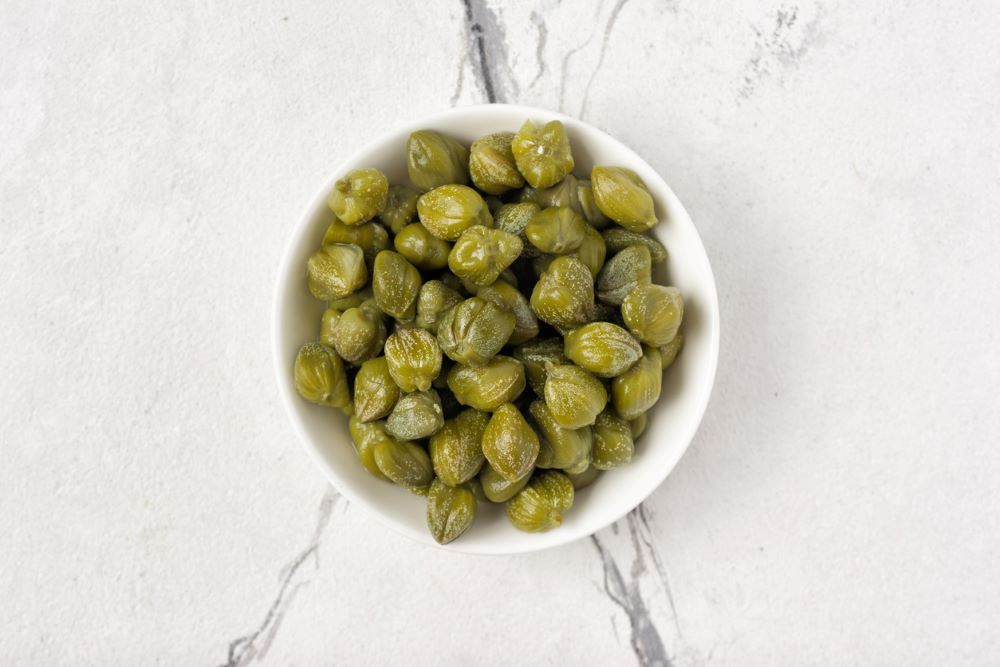
Just when it feels that the summer heat has positively scorched all living things in Cyprus, a leggy weed of a bush can be seen popping up all over the island. You might spot it in the medians of busy roads or even in parking lots, and it covers pretty much all areas of Cyprus, from the beaches to the mountains. I’m talking about the caper!
Native to the Mediterranean region, capers, or κάπαρη in Greek, are a wild flowering bush of a plant known widely for its edible buds, which are usually served preserved in salt or brine. I was surprised to discover that it’s not only the immature flower buds that are eaten here in Cyprus, but also the leaves and the “fruit” or berry – the larger, dangling bulb-like structures which you will find here and there if you look closely at a bush (these are actually what the blossoming flowers eventually turn into if they are not removed from the plant). You can find all three of these products in jars on most supermarket shelves on the island.
Collecting Your Caper Buds
If you are new to food foraging, here are a few things to keep in mind:
- Location – Aim to collect your caper buds from “clean” areas – areas far away from roadsides and car exhaust, away from industrial locations where contaminants might be in the soil, and away from areas that might be sprayed with pesticides or herbicides.
- Ownership – If you are foraging on someone’s land that is tended to, it would be good to get permission first. For example, foraging on public land would be better than stealing food from your neighbor’s backyard plants…
- Gear – Caper bushes are full of thorns, and picking the buds is a bit labor-intensive, as you have to pick one individual bud at a time. If you plan to collect a good amount, bring gloves to preserve your hands, and something to put the buds in (e.g., basket, bag, bucket). Also – watch out for ants and bees, who are attracted to the caper flowers!
- Maturity – The smaller buds tend to pickle better. Larger buds open up during the soaking process (see below).
Preserving Methods
There are three main ways of preserving or pickling caper buds, leaves and fruit:
- Dry salt method – Caper buds are stored in dry salt and soaked/rinsed later at the time of use.
- Brine + salt method – This is the method which I used and found to be easy for first-timers. See below for a sample recipe and ingredient proportions.
- Lacto-fermented method – This method takes advantage of the natural wild yeast spores in the air and on the caper buds, but I have not tried it myself, as I am happy with the salt + brine method and feel it leaves little room for error and molding.
Pickled Capers (Salt Preservation) Basic Recipe
This is a good base recipe which uses salt, vinegar and filtered water to preserve your capers.
Ingredients:
Caper buds, berries or leaves
Filtered water
Vinegar (either white or apple cider will work)
Instructions:
- Place your capers in a bowl or bucket, give them a good rinse with filtered water and discard any open or damaged buds, insects or other foreign objects.
- Drain and fill the bowl or bucket with enough clean water to cover the capers completely, and let them soak for 24 hours. Repeat this process three times (so capers are left soaking for three days total), discarding any buds which open up (open buds will lead to a mushy end-product). Soaking helps to leach out some of the bitter flavor from the plant parts.
- Drain and rinse the capers one last time, and decide what kind of jars or containers you will be using to pickle your capers. For example, you might want to use small glass jars if you plan to give some away, or a larger container for home storage. In addition, if you are planning to preserve any caper berries or leaves, you might consider separating them and putting them in their own jars, as the larger berries will take slightly longer to brine than small buds, for example.
- You will need equal amounts of (1) caper buds, (2) filtered water and (3) vinegar, plus some salt, equivalent to approximately 2 tbs. salt per 1 cup of caper buds/leaves/berries. This is not a hard ratio – extra salt won’t cause too much of a problem – but just as a guideline. Place your capers into your pickling containers, and then mix the water, vinegar and salt in a pitcher or flask. Pour this mixture over the capers – enough to cover them – and then let the jars/containers sit at room temperature for at least three days.
- Taste your product and see if you are satisfied with the level of brining. If so, place in the refrigerator. If not, leave out at room temperature for up to a week, and then store in the refrigerator until ready to consume. If you used the larger caper berries/fruit, they might take a few days longer to taste “ready” than small, immature buds.
How long do pickled capers last? I have pickled capers that are a year old (unopened) and still look and taste great. I am eager, however, to replace any stock that I have in the refrigerator with fresh batches from this year, just in the interest of rotating things out. As always, if you see any signs of black mold growth, or notice a change in taste, odor or color (capers will naturally darken as they age, but do not eat pickled buds that have turned brown or black)…when in doubt, throw it out!
Have you pickled capers before? Feel free to share your favorite recipe or brining recipe in the comments below!
Happy foraging!

